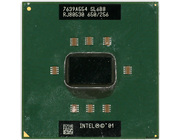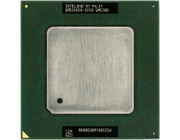The 'Tualatin' is used in the last iteration of Pentium III's. Both the last S370 Celeron and the Pentium III-S (with more L2-cache) use this core. It is made with a 130nm process and runs cool.
The fastest Pentium III-S 1400 'Tualatin', can out-perform the then new Pentium 4 'Willamette' and is often on-par with the AMD Athlon 1400 'Thunderbird'. Despite that the Pentium III performed better than the first generation Pentium 4, Intel decided not to continue with the Pentium III (i.e. 1500MHz models for example).
A new-in-box Mobile Pentium III processor. It's based on the efficient Tualatin core and runs at 1GHz with a 133MHz GTL+ FSB.
This CPU has been made in the 8th week of 2002, at the time the Mobile Pentium 4 was released at the time that Intel was busy developing 2.53GHz 'Northwood' samples and AMD had released it's Athlon XP 2000+ on the Palomino-core. The mobile sector didn't have (mobile) Pentium 4's until April 2002 so till then you'd had to be happy with a Pentium III 1GHz. And in 2002 that would not have been a problem at all ![]() . > Read more
. > Read more
A new version of the Celeron; the 'Tualatin' made on the 130nm process with 256KB L2-cache. It out-performs both the Celeron and more expensive Pentium III with the 'Coppermine' core. It's a fine CPU but by the time it was sold (this CPU is from 19th week of 2002), better CPU's we're available. Both the Pentium 4 'Northwood' and Athlon XP 'Palomino' we're common in the high-end market and are vastly better. > Read more
Like the Intel Celeron 1100A but 100MHz faster and about half a year newer. > Read more
Just like this Pentium III-S 1400 but with different sSpec number. The SL6BY version has a newer core compared to the SL5XL. > Read more
Pulled from a Compaq server as seen on the picture. Technically this CPU is the same as this Pentium III-S 1400. It only runs at a lower clock frequency.
The Pentium III-S is the fastest Pentium III processor around. It was made using a 130nm manufacturing process and has 512KB L2 cache. The normal Pentium III Tualatin without the -S only has 256KB L2 cache. > Read more
A qualification sample of Intel's Celeron 1100 with 'Tualatin'-core. It runs at 1100MHz and doesn't need as much voltage as the older Pentium III / Celeron CPU's because the Tualatin is made with the 130nm manufacturing process. > Read more
This type of Intel Pentium III processors performed very well. It was faster then the old Coppermine and even blew away the Intel Pentium 4 1,7GHz, which was much more expensive, in some benchmarks!
The '-S' mark defines the CPU as a server processor. These '-S' CPU's have 512KB L2 cache while the normal versions only have 256KB L2.
The Intel Pentium III-S 1400MHz is not common in desktop systems as it's a server CPU and it was quite expensive. A lot of people bought the AMD Athlon instead or got mislead by the higher GHz-mark of the Intel Pentium 4.
Enthusiasts tried to run these 'Tualatin'-CPU's in older Intel 440BX-chipset based boards and they succeeded! What an upgrade, getting your old Intel Pentium II or Celeron upgraded and beat the first generation P4 performance wise! The trick was to modify some of the hardware and use the correct Slotket (a convertor to use S370 CPU's in Slot1) which accepted FC-PGA2 CPU's.
Other enthusiasts could overclock the 0.13nm 'Tualatin' CPU's to extreme clock-frequencies. The record (as of end 2015) is 2.65GHz on a 1400MHz Celeron and 2.44GHz on a 1400MHz Pentium III-S. Of course these frequencies are so called suicide-runs (by far not stable for production) but it shows how far the CPU and north bridge (FSB) can go. > Read more
















